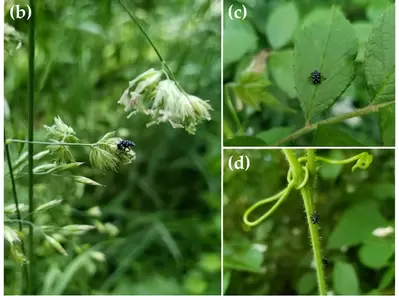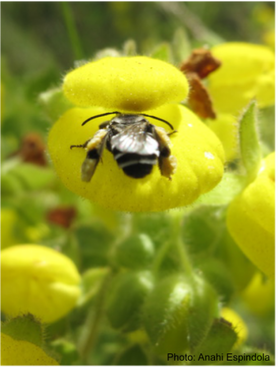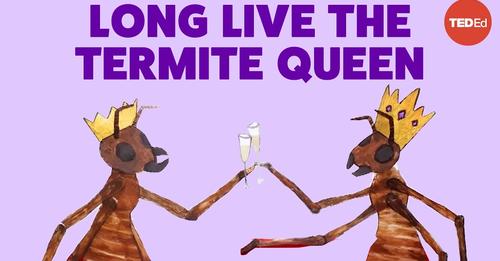|
Insect Terps in Fritz Lab collaborate with NC State University on genomic approach to identify signs of emerging pesticide resistance. From AGNR press release: “Global food security and protection of public health rely on the availability of effective strategies to manage pests, but as it currently stands, the evolution of resistance across many pests of agricultural and public health importance is outpacing the rate at which we can discover new technologies to manage them,” said Megan Fritz, an associate professor of entomology at UMD and senior author of the study. “I'm really excited about this study, because we're developing the framework for use of genomic approaches to monitor and manage resistance in any system.” Check out full AGNR press release here>>
Share your colleagues exciting work on social media (X , facebook) or wherever & however you like to spread science. "Legacy effects of long-term autumn leaf litter removal slow decomposition rates and reduce soil carbon in suburban yards," out in the journal Plants, People, Planet, is one of Burghardt Labs latest pubs. Their study finds that in places where people historically have left their fallen leaves to decompose, without removing them, the soil holds up to 32% more carbon on average. Check out AGNR's press release here. Includes quotes by Max Ferlauto and suggests some ways one can adopt leaf leaving practices in the landscapes they manage.
Share your colleagues work via facebook, X or over your yard fence to a neighbor. Dr. Nicolas Medina and Postdoc Mentor, Dr. Anahi Espindola, partnered up with Univ of Wyoming colleague Dr. David C. Tank to create a more robust evolutionary tree for Calceolaria. Using a new bait set gene sequencing method on recent and historic specimens of Calceolariaceae they were able to recover data for a wide range of DNA qualities at multiple phylogenetic scales. The results in this study demonstrate the efficacy of this new approach, which the authors hope, will be adopted for use in other systems. Their study entitled, "Calceolariaceae809: A bait set for targeted sequencing of nuclear loci", is out this week in Applications in Plant Sciences.
Share your colleagues' latest pub on X, facebook or other networks. In a paper just published in Developmental Biology, Matthew Fischer (MOCB alum), Patricia Graham (Research Scientist) and Leslie show that a regulatory element thought to be essential for gene expression in the early Drosophila embryo is actually not required for gene expression or for wild type development. They used CRISPR-Cas9 genome editing to remove this DNA region from the genome. Unexpectedly, flies homozygous for this deletion are viable, fertile, and perfectly healthy in the lab. This finding demonstrates the importance of using different types of techniques to tackle research questions. It also raises new questions about the evolution of regulatory elements and their roles in extant species.
Share your colleagues work on facebook, X and/or other platforms you use. Professors Mike Raupp and Paula Shrewsbury team up with U.S. Department of Agriculture and Washington State University colleagues to help put to rest long standing uncertainty on whether or not adult Magicicada cicadas eat. Spoiler Alert! They do. See publication in the Journal of Insect Science for the “full” story on cicadas' newly confirmed feeding behaviors.
For even more check out news articles interviewing lead researcher James R Hepler: https://phys.org/news/2023-10-adult-periodical-cicadas.html https://www.sciencenews.org/article/debunk-periodic-cicada-myth-guts https://www.earth.com/news/do-periodical-cicadas-eat-when-theyre-above-ground/ Share further on facebook, X and with your other networks. Dr. Magdalene Ngeve and Postdoc Mentor (Dr. Maile Neel), as well as other fellow UMD and UMCES researchers, published a study in Ecology and Evolution. They examined how tropical storms Irene and Lee affected the genetic diversity of aquatic plants in the lower Hudson River Estuary. Researchers collected samples of Vallisneria americana Michx. (Hydrocharitaceae) before and after the storms. Checking DNA markers, they were surprised to find the plants as a whole were able to sustain genetic diversity. However, they celebrate these findings with caution. These plant populations were already small and reproduced mainly asexually relying on making exact copies of themselves, which doesn't add to genetic diversity. If more severe storms and human disturbances continue along the Hudson, these plants might struggle to recover. For a more complete understanding of long-term resilience, the authors would like to see more ongoing monitoring of genetic diversity and population size.
Share your colleagues latest pub via facebook, x and your other networks. UMD Research Scientist, Rafael Barreto de Andrade (Gruner Lab), has been collaborating with European researchers on a pretty big project - consolidating multi-taxon biodiversity databases from more than 3,500 (!) sampling units across Europe, with the aim to inform conservation and management strategies for European forests. This summer their work was published in Biological Conservation.
Thanks Rafael for sharing the results of this very exciting collaboration! To share Rafael's collab further, consider retweeting, liking the mention on FB, shouting across the hall to your colleagues, etc. Back in 2021, an exciting entomological event happened in the DMV area. As part of Brood X, millions of periodical cicadas emerged in tandem, providing a unique opportunity for researchers to study these charismatic insects. Mary Salcedo from the Socha Lab of Virginia Tech contacted the UMD Cicada Crew, an Extension and Outreach group led by Dr. Raupp and Dr. Shrewsbury, with the intention of finding cicada emergence hubs to research insect wing expansion, and grad student Angela Saenz, a former member of the Cicada Crew, led the way and helped with their research. As stated in Salcedo et al. (2023), they found that during ecdysis, cicadas pump hemolymph through wing veins to expand their folded wing pads, and after pumping ~16% of their body mass, their fully expanded wings become even lighter than the wing pads. These findings provide new insights into the role of insects' circulatory system in wing expansion.
Congratulations to Entomology graduate students Katie Reding and Minh Le, from the Pick lab, for their publication "Genome editing of the vermilion locus generates a visible eye color marker for Oncopeltus fasciatus" in Scientific Reports. The study used CRISPR/Cas9 genome editing to generate an eye color mutant in Oncopeltus (Of). Bugs homozygous for mutations in the Of-vermillion gene are viable, fertile and have bright red rather than black eyes. This is the first visible, genetic marker for this species, paving the way for development of additional genetic tools in this emerging model system for Hemiptera. In addition, these studies mapped Of-vermillion to the X-chromosome, the first gene to be mapped to a chromosome in this species. Finally, experiments using RNAi showed that knocking down the Oncopeltus ortholog of the rosy gene (encoding xanthine dehydrogenase) in Of-vermillion mutants changed the body color from orange-red to yellow, thus identifying a second candidate gene useful as a visible marker.
 photo credit: Jim Evans photo credit: Jim Evans The beautifully bright French marigold with its yellow, orange and mahogany blooms proves to be a bit too attractive to beneficial arthropods surrounding sweet corn fields. During the 2021 field season, researchers in the Hooks Lab and UMD Extension were busy, “Evaluating French marigold as a border insectary plant for the enhancement of beneficial arthropods in sweet corn plantings.” They found that while the marigold plants were indeed attracting beneficial arthropods such as encyrtid wasps and lady beetles, the beneficials remained near the marigold strips rather than dispersing throughout the sweet corn plots. The authors concluded that “when used as a border insectary plant, marigold may not improve biological control through predation and parasitization of economically important insect pests in sweet corn plantings”. Moreover, in the current study, marigold may have functioned as a natural enemy sink by luring natural enemies from sweet corn border rows. Share your colleagues work with your networks. Here are a few posts ready to share via twitter and facebook. PhD student Anthony Nearman and Associate Professor Dennis vanEngelsdorp discovered that life spans of lab-kept honey bees are 50% shorter than they were in the 1970s. The College talks to Anthony about this latest paper:
“When I plotted the lifespans over time, I realized, wow, there’s actually this huge time effect going on,” Nearman said. “Standardized protocols for rearing honey bees in the lab weren’t really formalized until the 2000s, so you would think that lifespans would be longer or unchanged, because we’re getting better at this, right? Instead, we saw a doubling of mortality rate.” Check out the full AGNR press release for more about the study and implications of the findings. The College talks to Dr. Espíndola about latest paper:
Climate change is taking a serious toll on insects, UMD Entomology's Anahí Espíndola and dozens of scientists from around the world warned in a new paper published by the Ecological Society of America. “We need to realize, as humans, that we are one species out of millions of species, and there's no reason for us to assume that we’re never going to go extinct,” Anahí said. “These changes to insects can affect our species in pretty drastic ways.” Link to full press release here>> Graduate Student Mariom A. Carvajal (Shultz Lab) co-authors report with Universidad de Magallanes researcher Eduardo I. Faúndez on the southernmost lacewing - Hemerobiidae. This documentation of Hemerobiidae extends the known distribution of lacewings about 110km further south than previously recorded. https://go.umd.edu/cKn
Varroa mites and viruses they vector are leading causes of honeybee losses. University of Maryland researchers Drs Eugene Ryabov (Bee Lab) and Zachary Lamas (Hawthorne Lab) team up with U.S. Department of Agriculture to study varroa mite infectiousness and the effect of the vectored viruses on varroa survival. Last month they published their findings in Frontiers in Insect Science entitled, “The vectoring competence of the mite Varroa destructor for deformed wing virus of honey bees is dynamic and affects survival of the mite.” The authors hope this work will provide new insights into the varroa mites' impact on colony disease and ways to manage it.
Link to paper: https://www.frontiersin.org/articles/10.3389/finsc.2022.931352/full University of Maryland PhD candidate Kyle D. Brumfield and Drs. Rita Colwell and Michael Raupp, teamed up with colleagues from the University of Connecticut-Storrs, University of Connecticut-Hartford, University of California Berkeley, and EZbiome, Inc. to explore the rich diversity of the gut microbiome of periodical cicadas. For those interested in learning more about their research into these remarkable insects, check out publication out this week in Scientific Reports.
Link to article: https://www.nature.com/articles/s41598-022-20527-7 Spiders of the genus Steatoda, known as false black widows, have a resemblance to the black widow but are less harmful. However, around the world, there has been an increase of reports that this "less harmful" genus has been causing quite a debilitating bite. Heightened public concern has researchers, like grad student Mariom Adriana Carvajal (Shultz Lab), revisiting this genus. Mariom has been studying 1 of the 7 species found in Chile, taking a second look at its characteristics and its distribution. Today, Mariom and collegues published some of that work in Revista Chilena de Entomología, entitled, “A new record of Steatoda porteri in Chile.” Their findings show that although Steatoda porteri has extended its range, it remains outside urban areas for now.
 Photo Credit: Alireza Shokoohi Photo Credit: Alireza Shokoohi The bold beautiful colors of a 1 inch long adult spotted lanternfly are pretty hard to miss. Their striking attributes allow for researchers to make many experimental observations about the insects, including discoveries about their feeding preferences as adults. However, at the earliest instars the spotted lanternflies are smaller and muted in color making feeding preferences much more difficult for researchers to track by observation alone. To overcome the difficulties of the observational approach, the Lamp Lab turns to DNA metabarcoding to get more insights about their diet. The results of their study were published earlier this summer in a special issue of Insects. Focusing exclusively on the first nymphal instars, the Lamp Lab used a novel approach, utilizing “bulk” DNA extracts for DNA metabarcoding of nymphal gut contents, to identify plants that the nymphs had ingested prior to being collected. Through this novel approach they were able to identify 13 novel host plants that have not been previously included in host plant lists for spotted lanternfly in the U.S. The Lamp Lab is hopeful that discoveries like these, on the diet of the spotted lanternfly across development stages, will lead to better management of this invasive species. Share your colleagues work with your networks on facebook, twitter, the car ride with your friends who are always asking you about bugs b/c you work in Entomology. Metarhizium is a common fungus that is found in soil and widely used in insect pest control today. It is known for its ability to kill a wide range of insects, protect surrounding plants and provide plants with much sought after nitrogen. St. Leger Lab has a new paper out in Current Opinion in Microbiology that looks into the current research on this fungi and its–plant–insect interactions. Although experimentation has led to detailed knowledge of how this fungus interacts with plants and insects, most of these studies have focused on highly controlled interactions between single species in the lab, leading to a knowledge gap when it comes to understanding Metarhizium plant–insect interactions in natural communities. The authors hope an increase in Metarhizium studies on natural ecosystems will lead to a more comprehensive understanding of this fungi’s plant protection ability.
Before concluding a shout out is needed. Congrats to Huiyu Sheng, this is her 1st first-authored paper, and to Raymond St. Leger her proud UMD mentor. Please share news with friends, colleagues & that one fungi you met while at your last conference: facebook and twitte The emerald ash borer (EAB) is a small and mesmerizing beauty and also one of the most destructive invasive species in the US. Since its introduction to the US in 2002 it has killed millions of ash trees causing serious economic and ecological damage. One approach for long term EAB management has been to introduce parasitic wasps from EAB’s native range to the US for biocontrol. A recent study by UMD and USDA researchers, Stokes Aker, Rafael de Andrade, Jian Duan and Dan Gruner – published this year in the Journal of Economic Entomology – takes a closer look at the performance of these wasps.
Their study suggests that Spathius galinae has a higher recovery and spatial spread compared to Spathius agrili, at least in Maryland. The authors would like to see continued monitoring and evaluation of both species to gain a better understanding of why one parasitoid appears to have gained a better foothold in Maryland than the other. Information like this is important to improve the efficacy of current biocontrol programs against EAB in North America. Before concluding a shout out is needed. Congrats to Stokes Aker this is his 1st first-authored paper, and to Dan Gruner his proud UMD mentor. Beyond the honeybee: How many bee species does a meadow need for pollination and ecosystem health? Way more than previously known according to a new study by UMD Ento's postdoctoral associate Michael Roswell. Follow link to read full AGNR article, https://go.umd.edu/qD2
Share on facebook: https://www.facebook.com/UMDAGNR/posts/10159818456417248 Share on twitter: https://twitter.com/UMD_AGNR/status/1514231618260586502?s=20&t=NsKizr_un7P_ZwbYR3mC_A Eriophyid mites, aka rust, gall and bud mites feed on all kinds of plants and have been estimated that there are close to a million species on the planet. Several species of eriophyid mites can cause stunting, curling and brown discoloration of leaves on host plants leading to millions of dollars in losses in production on grasses, ornamentals, forest and fruit trees. So what can farmers and other agricultural agents do to manage these mites? And can management be done sustainably?
Researchers from the University of Maryland Department of Entomology Professor Emeritus Galen Dively and MS student Maggie Hartman team up with USDA's Ron Ochoa to investigate a more sustainable strategy for mite management involving the integration of chemical control, host plant resistance, and cultural practices. Their study, "Population Dynamics of Eriophyid Mites and Evaluation of Different Management Practices on Timothy Grass" published this month in the Journal of Economic Entomology, is the first to demonstrate the relative effectiveness of alternative management practices that could reduce the need for chemical control of eriophyoid mites on timothy grass. Read the paper here>>. Share with your networks via Facebook, Twitter, etc.  The beautiful and abundant plant genus Calceolaria L. is one of most iconic Andean plant genera. However, its evolutionary relationships have remained evasive despite dozens of years of research. Further understanding of the evolutionary history of the group can hold the key to recognizing patterns of diversification across the world's largest mountain ranges, the Andes. Researchers Lauren Frankel (former researcher in the EspindoLab), Dr. Murúa and Dr. Espindola’s latest paper – published this week by the Botanical Journal of the Linnean Society – used chloroplastic genome analyses to help fill in the gap of Calceolaria’s evolutionary history. Through this approach they were able to resolve for the first time the backbone of the genus, identify two main clades that also display interesting pollination-relevant traits, and estimate a timing of diversification contemporaneous to major climatic and orogenic events. Check out paper here>> Additional shout out to Lauren Frankel; this is her 1st first-authored paper, and to Anahi Espindola her proud UMD mentor. Fun fact, this is the same journal in which Anahi had her first first-author paper published! Please share with networks on facebook, twitter, etc. ^Eckert RA, Lamp WO and Marbach-Ad G. Jigsaw dissection activity enhances student ability to relate morphology and ecology in aquatic insects. Journal of Biological Education. 2021 DOI: https://doi.org/10.1080/00219266.2021.2006268
^Evans K, Underwood RM and López-Uribe MM. Combined effects of oxalic acid sublimation and brood breaks on Varroa mite ( Varroa destructor ) and deformed wing virus levels in newly established honey bee ( Apis mellifera ) colonies. Journal of Apicultural Research. 2021. DOI: https://doi.org/10.1080/00218839.2021.1985260 Satler JD, Carsten BC, Garrick RC and Espíndola A. The Phylogeographic Shortfall in Hexapods: A Lot of Leg Work Remaining. Insect Systematics and Diversity. 2021. https://doi.org/10.1093/isd/ixab015 Tait G, Mermer S, Stockton D [and 46 others including Hamby KA and ^Schöneberg T]. Drosophila suzukii (Diptera: Drosophilidae): A Decade of Research Towards a Sustainable Integrated Pest Management Program. Journal of Economic Entomology. 2021. DOI: https://doi.org/10.1093/jee/toab158 Marsden BW, Ngeve MN, Engelhardt KAM and Neel MC. Assessing the Potential to Extrapolate Genetic-Based Restoration Strategies Between Ecologically Similar but Geographically Separate Locations of the Foundation Species Vallisneria americana Michx. Estuaries and Coasts. 2021. DOI: https://doi.org/10.1007/s12237-021-01031-z *Graham PL, ^Fischer MD, Giri A, and Pick L. The fushi tarazu zebra element is not required for Drosophila viability or fertility. G3 Genes|Genomes|Genetics. 2021. DOI: https://doi.org/10.1093/g3journal/jkab300 Kard BM, OI FM, Thorne BL, Forschler BT and Jones SC. Performance Standards and Acceptable Test Conditions for Preventive Termiticide and Insecticide Treatments, Termite Baiting Systems, and Physical Barriers for New Structures or Buildings Under Construction (Pre-Construction; During Construction; Post-Construction). Florida Entomologist. 2021. DOI: https://doi.org/10.1653/024.104.0308 Hensel MJS, Silliman B., van de Koppel J, Hensel E, ^Sharp SJ, Crotty SM and Byrnes JEK. A large invasive consumer reduces coastal ecosystem resilience by disabling positive species interactions. Nature Communications. 2021. DOI: https://doi.org/10.1038/s41467-021-26504-4 Bold ENTM Faculty; ^ENTM current/former graduate student or post-doc; *ENTM research staff In 2017, Professor Sara Via started a collaboration with the Maryland Department of Agriculture on soil health and how farmers can manage their land to store carbon in agricultural soils. As part of this collaboration and her role as one of Maryland's representatives to the Natural and Working Lands Workgroup of the US Climate Alliance, Dr. Via began a review of the scientific literature on the topic to evaluate the carbon-sequestering effectiveness of a set of 23 practices, including reduced tillage and the use of cover crops. This review led to a comprehensive report that demonstrates how increased adoption of these key practices can make agriculture a significant part of the American climate solution. The report, titled “Increasing Soil Health and Sequestering Carbon in Agricultural Soils: A Natural Climate Solution” highlights a set of farming practices that improve soil health, reduce greenhouse gas emissions, and store carbon in the soil while providing economic benefits for farmers and environmental benefits for all. The table of expected GHG reductions from using each of the recommended practices was integrated into Maryland's 2030 Greenhouse Gas Reduction Act Plan as Appendix K. For more information and to download the report, check out publisher Izaak Walton League of America’s press release here>>.
|
Categories
All
Archives
June 2024
|
Department of Entomology
University of Maryland
4112 Plant Sciences Building
College Park, MD 20742-4454
USA
Telephone: 301.405.3911
Fax: 301.314.9290
University of Maryland
4112 Plant Sciences Building
College Park, MD 20742-4454
USA
Telephone: 301.405.3911
Fax: 301.314.9290


 RSS Feed
RSS Feed




